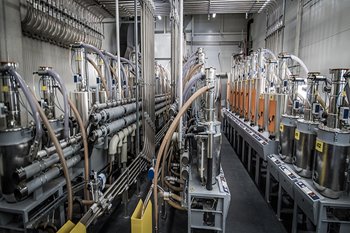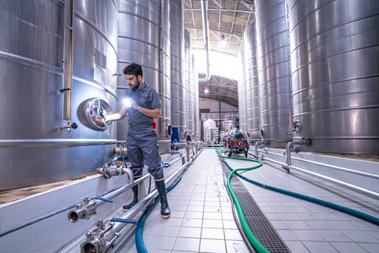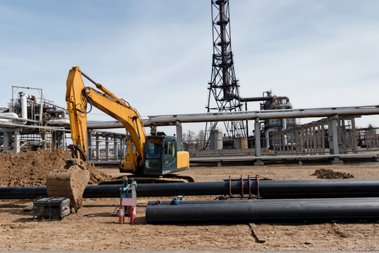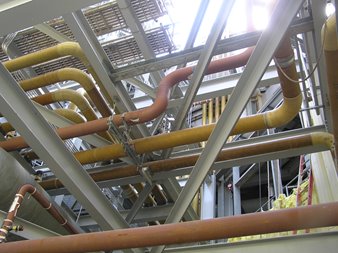Explore 5 Applications of Nonmetallic Piping Systems
Explore 5 Applications of Nonmetallic Piping Systems


ASME’s new standards will help guide engineers in their designs as they explore the world of plastic and nonmetallic pressure piping systems.
Nonmetallic (NM) pressure piping systems have risen in use over the last decade. Recent innovations in material science have led to the creation of new pipes, composed of thermoplastic and fiber-reinforced thermosetting-resins, that can handle high pressures and temperatures.
To support the many industries who are actively using nonmetallic pressure piping systems, ASME released its NM standards, which address the unique design and construction requirements associated with nonmetallic pressure piping systems. The new 2020 edition includes:
Listen to ASME TechCast: Simplifying Nonmetallic Pressure Piping Systems
Let’s explore some of the industries where nonmetallic pressure piping systems are being used, some common challenges found within these industries, and how the NM standards are helping companies address them.
Chemical process plants are one of the most challenging environments for industrial piping systems. The combination of aggressive chemicals and high temperatures can compromise the long-term integrity of many piping materials. This can lead to costly repairs, due to leaks, contamination, and other premature failures. ASME's NM standards help companies identify the appropriate piping materials and system for their facility in order to mitigate these risks. The standards guide them across the consideration process, taking into account things such as load conditions, allowable stress values, installation and quality control. Companies need to think strategically about their facilities and invest in the right tools, materials, and resources. This will help their facilities operate safely, efficiently, and effectively for the long term.
In the food and beverage industry, the safety and sanitary conditions of a facility are paramount. Elements of a facility’s design, such as the piping systems used to transport water, air, or the products themselves, should be closely examined to ensure the appropriate materials and components are in place. Otherwise, the taste, texture, and overall quality of these products could be compromised. Investing in the right tools, materials, and resources will enable companies to provide the quality products their customers demand. And will allow them to operate in a safe, efficient, and effective manner.
The new NM standards help companies plan, design, and build nonmetallic pressure piping systems that meet essential requirements. The standards guide companies across the design process, helping them take into account important considerations such as what substances will pass through their pipes, the pressures and temperatures they’ll be exposed to, along with other environmental conditions. For this industry, food-grade plastics, such as high-density polyethylene (HDPE), are commonly used, due to their flexibility, low-gas permeability, resistance to mold, and compliance with FDA and NSF requirements.
Oil and gas companies face many environmental challenges when designing, building, and maintaining their pipelines. From the frigid temperatures and highly corrosive effects of deep underwater sea trenches to the extremely high temperature and pressure conditions found when drilling underground, these organizations require the tools, knowledge, and resources to support their evolving needs.
ASME’s new NM standards guide companies across the design process by helping them to think through key factors, such as which materials can handle the highly corrosive nature of seawater across the life of the project or what physical and mechanical properties are needed to withstand strong underwater currents or even seismic activity. The NM standards provide a single, centralized resource that addresses the unique construction requirements of nonmetallic pressure piping systems along with the many challenging applications Oil & Gas companies face every day.
Power plants and industrial facilities create hydrogen chloride and sulfur dioxide as a by-product of different operational processes. When in contact with clouds, sulfur dioxide can cause acid rain to form. To prevent this, companies incorporate air-pollution control systems, which filter the gas through a slurry mixture of water and lime, removing the acidic elements from the flue gases. This requires a reliable piping system for transporting the slurry, which can withstand this acidic and highly corrosive mixture.
ASME’s new NM standards help companies plan, design, and build nonmetallic pressure piping systems that can support these challenging operating conditions. They guide industry professionals through the careful selection of materials, such as fiber-reinforced thermosets, which can stand up to these highly corrosive slurries. And help companies identify the appropriate testing, inspection, and evaluation criteria needed to implement an effective and reliable piping system.
Recommended for You: 6 Insurances for Safe Hydraulic Hose Assemblies
Companies in the water and wastewater industry face many operational challenges, including the design, build, and maintenance of piping systems that are expected to be in service for over 50 years. This, in addition to an ever-evolving set of federal, state, and local standards, requires companies to think strategically, investing in the right tools, materials, and resources to operate in a highly efficient and effective manner.
ASME’s new NM standards guide industry professionals through important consideration points to keep in mind when choosing a material, such as the method of construction, water chemistry, pressure and temperature ratings, and more. This empowers companies to make better decisions, so their nonmetallic pressure piping systems will not only stand up to the highly corrosive elements found within wastewater treatment plants but also stand the test of time.
ASME’s Nonmetallic Pressure Piping Systems standards provide the knowledge and expertise to design and build a reliable piping solution that can save time and money over the life of a project. The new 2020 edition offers a single, centralized resource for designing, manufacturing, erecting, examining, testing, and inspecting nonmetallic pressure piping systems.
Carlton R. Ramcharran is a S&C project engineering advisor at ASME.
Explore ASME's Nonmetallic Pressure Piping System Standards
To support the many industries who are actively using nonmetallic pressure piping systems, ASME released its NM standards, which address the unique design and construction requirements associated with nonmetallic pressure piping systems. The new 2020 edition includes:
- ASME NM.1, Standard on Thermoplastic Piping Systems
- ASME NM.2, Standard on Glass-Fiber-Reinforced Thermosetting-Resin Piping Systems
- ASME NM.3, Standard on Nonmetallic Materials
Listen to ASME TechCast: Simplifying Nonmetallic Pressure Piping Systems
Let’s explore some of the industries where nonmetallic pressure piping systems are being used, some common challenges found within these industries, and how the NM standards are helping companies address them.
Chemical Processing
Chemical process plants are one of the most challenging environments for industrial piping systems. The combination of aggressive chemicals and high temperatures can compromise the long-term integrity of many piping materials. This can lead to costly repairs, due to leaks, contamination, and other premature failures. ASME's NM standards help companies identify the appropriate piping materials and system for their facility in order to mitigate these risks. The standards guide them across the consideration process, taking into account things such as load conditions, allowable stress values, installation and quality control. Companies need to think strategically about their facilities and invest in the right tools, materials, and resources. This will help their facilities operate safely, efficiently, and effectively for the long term.
Food and Beverage Industry
In the food and beverage industry, the safety and sanitary conditions of a facility are paramount. Elements of a facility’s design, such as the piping systems used to transport water, air, or the products themselves, should be closely examined to ensure the appropriate materials and components are in place. Otherwise, the taste, texture, and overall quality of these products could be compromised. Investing in the right tools, materials, and resources will enable companies to provide the quality products their customers demand. And will allow them to operate in a safe, efficient, and effective manner.
The new NM standards help companies plan, design, and build nonmetallic pressure piping systems that meet essential requirements. The standards guide companies across the design process, helping them take into account important considerations such as what substances will pass through their pipes, the pressures and temperatures they’ll be exposed to, along with other environmental conditions. For this industry, food-grade plastics, such as high-density polyethylene (HDPE), are commonly used, due to their flexibility, low-gas permeability, resistance to mold, and compliance with FDA and NSF requirements.
Oil and Gas Industry
Oil and gas companies face many environmental challenges when designing, building, and maintaining their pipelines. From the frigid temperatures and highly corrosive effects of deep underwater sea trenches to the extremely high temperature and pressure conditions found when drilling underground, these organizations require the tools, knowledge, and resources to support their evolving needs.
ASME’s new NM standards guide companies across the design process by helping them to think through key factors, such as which materials can handle the highly corrosive nature of seawater across the life of the project or what physical and mechanical properties are needed to withstand strong underwater currents or even seismic activity. The NM standards provide a single, centralized resource that addresses the unique construction requirements of nonmetallic pressure piping systems along with the many challenging applications Oil & Gas companies face every day.
Power Plant and Industrial Facilities
Power plants and industrial facilities create hydrogen chloride and sulfur dioxide as a by-product of different operational processes. When in contact with clouds, sulfur dioxide can cause acid rain to form. To prevent this, companies incorporate air-pollution control systems, which filter the gas through a slurry mixture of water and lime, removing the acidic elements from the flue gases. This requires a reliable piping system for transporting the slurry, which can withstand this acidic and highly corrosive mixture.
ASME’s new NM standards help companies plan, design, and build nonmetallic pressure piping systems that can support these challenging operating conditions. They guide industry professionals through the careful selection of materials, such as fiber-reinforced thermosets, which can stand up to these highly corrosive slurries. And help companies identify the appropriate testing, inspection, and evaluation criteria needed to implement an effective and reliable piping system.
Recommended for You: 6 Insurances for Safe Hydraulic Hose Assemblies
Water Industry
Companies in the water and wastewater industry face many operational challenges, including the design, build, and maintenance of piping systems that are expected to be in service for over 50 years. This, in addition to an ever-evolving set of federal, state, and local standards, requires companies to think strategically, investing in the right tools, materials, and resources to operate in a highly efficient and effective manner.
ASME’s new NM standards guide industry professionals through important consideration points to keep in mind when choosing a material, such as the method of construction, water chemistry, pressure and temperature ratings, and more. This empowers companies to make better decisions, so their nonmetallic pressure piping systems will not only stand up to the highly corrosive elements found within wastewater treatment plants but also stand the test of time.
ASME’s Nonmetallic Pressure Piping Systems standards provide the knowledge and expertise to design and build a reliable piping solution that can save time and money over the life of a project. The new 2020 edition offers a single, centralized resource for designing, manufacturing, erecting, examining, testing, and inspecting nonmetallic pressure piping systems.
Carlton R. Ramcharran is a S&C project engineering advisor at ASME.
Explore ASME's Nonmetallic Pressure Piping System Standards










